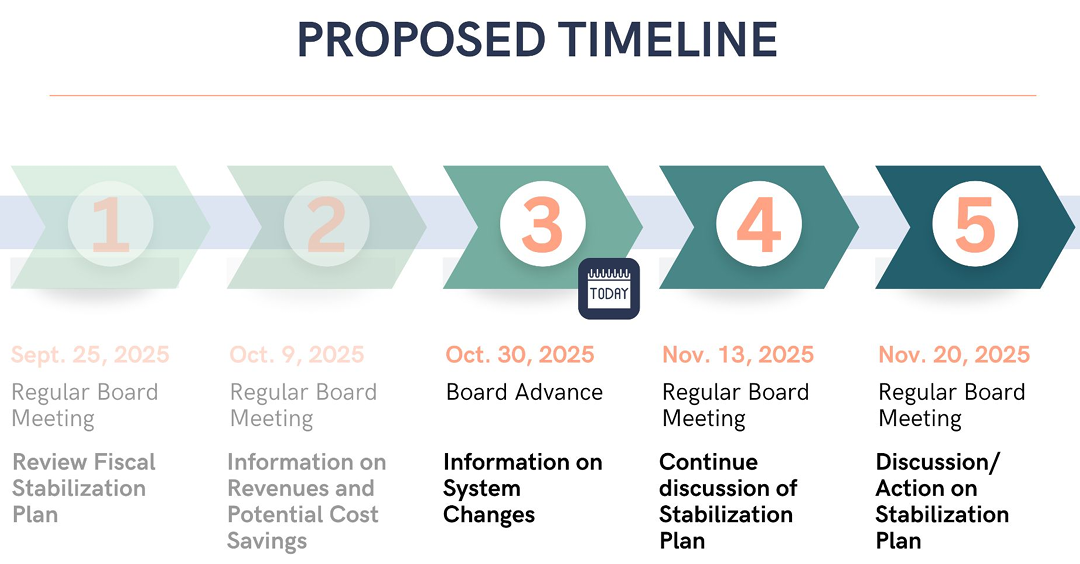CUSD Fiscal Stabilization Plan
-
Overview
The Cupertino Union School District (CUSD) is addressing ongoing budget challenges through a fiscal stabilization plan. This initiative aims to reduce deficits proactively, maintain adequate reserves, and minimize impacts on educational programs. The following provides background on the current fiscal situation and proposals discussed at the October 30, 2025, Board Advance meeting.
Current Fiscal Context
CUSD faces pressures from declining enrollment, lost local revenues, and external funding uncertainties:
-
Deficits: Fiscal Year (FY) 2024-2025 closed with a deficit exceeding $26 million. FY 2025-2026 projections indicate a shortfall of more than $11 million.
-
Reserves: Board-designated reserves are expected to drop below 5% of the annual budget, compared to the district's 10% target. Neighboring districts often maintain around 20% reserves for added stability.
-
Revenue Loss: The district has lost approximately $8 million annually from the expired parcel tax since 2024.
-
Broader Factors: Federal cuts and state budget volatility, including Local Control Funding Formula (LCFF) adjustments, exacerbate challenges for Basic Aid districts like CUSD.
These trends underscore the need for targeted efficiencies to avoid larger program reductions in the future.
Board Advance Discussion: Targeted Reductions
District staff presented a plan for $8 million in savings, focusing on:
-
Middle school elective offerings
-
Transitional Kindergarten (TK) adjustments
-
Early retirement incentives
-
Cuperdoodle program changes
Emphasis is on middle school electives and TK, potentially yielding $4–5 million combined. Details follow.
Middle School Electives
Electives such as band, foreign languages, woodshop, and photography support student engagement. Recent changes include:
-
Pre-2025: Offerings varied by school (e.g., two electives for 7th/8th graders at some sites, one for 6th graders).
-
FY 2025-2026: Expansion to two electives for all 6th–8th graders, enabled by enrollment declines without new hires.
With continued enrollment at lower levels, proposed options balance access and costs:
-
Option 1: 7th/8th graders may opt for a second elective; 6th graders receive one. Projected impact: ~18 full-time employees (FTEs) reduction in middle school staff. Estimated savings: ~$2.1 million.
-
Option 2: All 7th/8th graders receive two electives; 6th graders receive one. Projected impact: ~13 FTEs reduction. Estimated savings: ~$1.5 million.
-
Option 3 (Status Quo): All 6th–8th graders receive two electives, accounting for enrollment declines. Projected impact: Minimal staff changes. Estimated savings: ~$0.6 million.
-
Option 4: All 6th–8th graders may opt for a second elective (voluntary). Projected impact: Savings pending analysis; aligns staffing with participation. Estimated savings: To be determined.
All options ensure at least one elective per student.
Transitional Kindergarten (TK)
TK, a statewide pre-K program for four-year-olds, aids kindergarten readiness but poses funding issues for Basic Aid districts:
- No state funding per TK student (vs. ~$5,545 extra for LCFF districts).
- Mandated 1:10 adult-to-pupil ratio (vs. 1:20 or more for other grades), nearly doubling per-pupil costs.
Serving ~720 students currently, proposed adjustments include:
-
Option 1: Half-day classes; no enrollment cap. Projected impact: TK teachers and instructional assistants (IAs) reduced to 60% contracts. Estimated savings: ~$2.5 million.
-
Option 2: Full-day classes; cap enrollment at 360 students. Projected impact: ~36 teacher/IA positions eliminated. Estimated savings: ~$3.2 million.
-
Option 3: Split-day classes (e.g., alternating schedules). Projected impact: ~36 teacher/IA positions eliminated. Estimated savings: ~$2.5 million.
These maintain significant TK capacity while reallocating resources to K–8 priorities.
Next Steps
The board will review and vote on the stabilization plan at the board meeting on 11/20/2025.

-